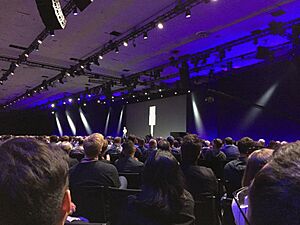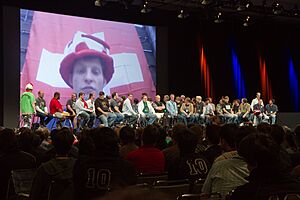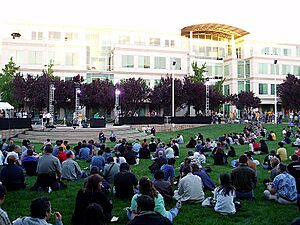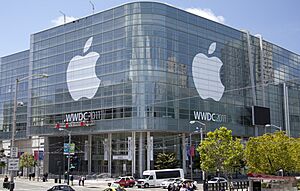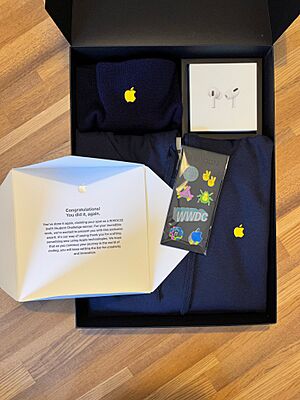Worldwide Developers Conference facts for kids
Quick facts for kids WWDC |
|
|---|---|
 |
|
| Status | Active |
| Genre | Conference |
| Frequency | Annually (since 1989) |
| Venue | Apple Park/Virtual (since 2020) |
| Location(s) | Cupertino, California/Virtual (since 2020) |
| Country | United States |
| Years active | 41 |
| Inaugurated | 1983 |
| Founder | Apple Inc. |
| Most recent | June 9–13, 2025 YouTube |
| Previous event | June 10–14, 2024 |
| Next event | June 2026 |
| Attendance | 23 million online viewers (2020) |
| Area | Worldwide |
| Budget | USD$50 million |
| Organized by | Apple Inc. |
The Worldwide Developers Conference (WWDC) is a big event held every year by Apple Inc.. It takes place at Apple Park in California. At WWDC, Apple shows off its newest software and technologies. This includes updates for macOS, iOS, iPadOS, watchOS, tvOS, and visionOS. Sometimes, new hardware products are also announced.
WWDC is also a special event for people who create apps for iPhones, iPads, Macs, and other Apple devices. These app creators, called developers, can work with Apple engineers. They also attend sessions to learn about many different topics.
The first WWDC happened in 1983. But it wasn't until 2002 that Apple started using it to launch major new products. For many years, WWDC was held in San Francisco. It became Apple's main event of the year and tickets always sold out fast. Later, it moved back to San Jose.
WWDC 2020 and 2021 were online-only events because of the COVID-19 pandemic. In 2022, developers and the media came back to Apple Park. Customers could still watch the event online. WWDC 2023, 2024, and 2025 were held both online and in person. The most recent conference, WWDC 2025, took place from June 9 to June 13, 2025.
Contents
- Getting into WWDC
- What Happens at WWDC
- History of WWDC
- Early Years: 1980s
- 1990s: Software Evolution
- 2000s: Mac OS X and iPhone Era
- 2010s: iOS and macOS Updates
- 2010: iPhone 4 and iOS Renaming
- 2011: iCloud and Mac OS X Lion
- 2012: Apple Maps and Retina MacBook Pro
- 2013: iOS 7 Redesign
- 2014: iOS 8 and Swift
- 2015: Apple Music and Open Source Swift
- 2016: macOS Sierra and Siri for Developers
- 2017: Return to San Jose and iMac Pro
- 2018: Focus on Software
- 2019: iPadOS and New Mac Pro
- 2020s: Online and Hybrid Events
- Scholarships for Students
- Other Events
- See also
Getting into WWDC
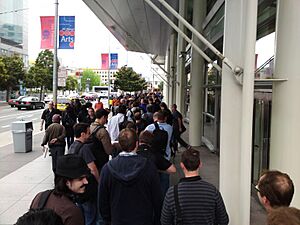
Before 2020, a ticket to WWDC cost $1,599. You had to win a lottery online to get one. Apple offers special scholarships for students and members of STEM groups. These scholarships help young people attend for free. To go, you must be at least 13 years old. You also need to be part of an Apple Developer program.
In the past, between 2,000 and 4,200 people attended. But in 2007, Steve Jobs said over 5,000 people were there. From 2008 to 2015, the event was limited to 5,000 attendees. WWDC 2018 had 6,000 attendees from 77 countries. This included 350 students who received scholarships.
What Happens at WWDC
WWDC usually runs from Monday to Friday in June. The conference has a main speech, learning sessions, one-on-one help, and fun get-togethers.
The conference starts with a big keynote speech on Monday morning. Tim Cook and other Apple leaders give this speech. (Before 2011, Steve Jobs gave this speech, which was called the Stevenote.) Both attendees and the media watch this. Apple often announces new products during this speech. Sometimes, new hardware is shown in the conference hall afterward.
After the keynote, there's a Platforms State of the Union speech. This talk shows off changes in Apple's software developer tools. These changes are explained in more detail later in the week. The Apple Design Awards are also announced on the first day. These awards celebrate the best apps.
From Tuesday to Friday, many different sessions happen at the same time. These talks cover programming, design, and other topics. They range from easy to advanced. Most talks are given by Apple employees. You can watch these talks live online. Recordings are also available on the Apple Developer website. There are also special lunchtime talks by experts in technology and science.
Throughout the week, Apple engineers are available for one-on-one help. They meet with developers at "labs." Experts in user interface design and accessibility also offer advice.
Apple also organizes social events. These are for different groups, like women in technology. There's also a big party on Thursday evening. It has live music, food, and drinks for everyone 21 or older.
History of WWDC
WWDC has changed a lot since it started. It began as a smaller conference and grew into a huge event.
| Year | Dates | Venue | Ref. |
|---|---|---|---|
| Apple Independent Software Developers Conference | |||
| 1983 | August 8–10 | Dunfey Hotel | |
| Apple II Forever | |||
| 1984 | April 23–24 | Moscone Center | |
| Apple World Conference | |||
| 1986 | January 15–17 | Brooks Hall | |
| 1987 | March 2–3 | Universal Amphitheatre | |
| Apple Developers Conference (DevCon) | |||
| 1987 | early April | Santa Clara Convention Center | |
| 1988 | late April | San Jose Convention Center | |
| September | |||
| 1989 | May 8–12 | ||
| Worldwide Developers Conference (WWDC) | |||
| 1990 | May 7–11 | San Jose Convention Center | N/A |
| 1991 | May 13–17 | ||
| 1992 | May 11–15 | ||
| 1993 | May 10–14 | ||
| 1994 | May 16–20 | ||
| 1995 | May 8–12 | ||
| 1996 | May 13–17 | ||
| 1997 | May 12–16 | ||
| 1998 | May 11–15 | ||
| 1999 | May 10–14 | ||
| 2000 | May 15–19 | ||
| 2001 | May 21–25 | ||
| 2002 | May 6–10 | ||
| 2003 | June 23–27 | Moscone West | |
| 2004 | June 28 – July 2 | ||
| 2005 | June 6–10 | ||
| 2006 | August 7–11 | ||
| 2007 | June 11–15 | ||
| 2008 | June 9–13 | ||
| 2009 | June 8–12 | ||
| 2010 | June 7–11 | ||
| 2011 | June 6–10 | ||
| 2012 | June 11–15 | ||
| 2013 | June 10–14 | ||
| 2014 | June 2–6 | ||
| 2015 | June 8–12 | ||
| 2016 | June 13–17 | Bill Graham Civic Auditorium Moscone West |
|
| 2017 | June 5–9 | San Jose Convention Center | |
| 2018 | June 4–8 | ||
| 2019 | June 3–7 | ||
| 2020 | June 22–26 | Digital conference | |
| 2021 | June 7–11 | ||
| 2022 | June 6–10 | Apple Park (video presentation, day one only) | |
| 2023 | June 5–9 | ||
| 2024 | June 10–14 | ||
| 2025 | June 9–13 | ||
Early Years: 1980s
1983: First Developer Conference
The very first WWDC was in 1983. It was called The Apple Independent Software Developers Conference. People who attended had to sign a special agreement. So, not much is known about it. But attendees did get a first look at Lisa. This was the world's first personal computer with a graphical interface.
1984: Macintosh Debut
In 1984, Steve Jobs showed off the famous Macintosh to developers. This was Apple's second computer with a graphical interface. This year was also the first time the conference was open to the media.
1986: Apple World Conference
The 1986 Apple World Conference was in San Francisco. It had over 400 exhibitors. Many companies showed off products for Apple II and Macintosh. People could buy computer accessories and software. Apple also introduced the LaserWriter Plus printer.
1987: New Macs and Networking
The 1987 AppleWorld Conference celebrated Apple's tenth birthday. New products were introduced. Apple showed the Macintosh SE and Macintosh II. The Macintosh II was the first Mac to support A/UX, Apple's version of Unix. Apple also announced working with 3Com on EtherTalk. This was an Ethernet version of the AppleTalk network.
1989: System 7 Announced
In 1989, Apple announced System 7. This was a major update to the Mac operating system.
1990s: Software Evolution
1991: QuickTime Arrives
In 1991, WWDC saw the first public showing of QuickTime. This software lets computers play videos and sounds.
1997: Steve Jobs Returns
WWDC 1997 was special because Steve Jobs returned to Apple. The conference focused on using OPENSTEP as the base for the next Mac OS. This new system was called Rhapsody. It would combine OPENSTEP with a Mac-like look.
1998: Carbon and Quartz
In 1998, Apple announced Carbon. This made it easier for developers to update their old Mac apps for the new Mac OS X. This meant apps could use new features like protected memory. Another big announcement was Quartz. This was a new way for the computer to draw images on the screen.
1999: Darwin and Cocoa
WWDC 1999 was a progress report. Apple made the core of its new operating system open source. This was called Darwin. The system previously called Yellow Box was officially renamed Cocoa. Over 2,500 developers attended.
2000s: Mac OS X and iPhone Era
2000: Mac OS X Nears Release
WWDC 2000 was another update before Mac OS X was released. New features included a changed dock and better developer tools. About 3,600 developers attended.
2001: Mac OS X Server
In 2001, Mac OS X had just come out. WWDC 2001 added the first release of Mac OS X Server. Over 4,000 developers attended.
2002: Farewell to Mac OS 9
In 2002, Apple showed Mac OS X v.10.2 and QuickTime 6. Apple also held a mock funeral for Mac OS 9. They told developers that all future work would be on Mac OS X. This meant the end for the Classic Mac OS operating system.
2003: Power Mac G5 and Safari
WWDC 2003 showed the Power Mac G5 computer. Apple also previewed Mac OS X Panther (10.3). They announced the official launch of Safari 1.0. Attendees received Apple's first iSight web camera. About 3,000 developers attended.
2004: Mac OS X Tiger Preview
In 2004, WWDC had 3,500 developers. Mac OS X Tiger (10.4) was previewed. iTunes 4.9, with podcast support, was shown. Attendees received a preview of Tiger.
2005: Macs Switch to Intel
WWDC 2005 had a huge announcement. Steve Jobs said that Macs would start using Intel processors. This was a big change from the PowerPC chips they used before. Over 3,800 attendees from 45 countries were there.
2006: Mac Pro and Leopard Preview
In 2006, the Mac Pro was announced. This new computer replaced the Power Mac G5. Apple also showed off 10 new features for Mac OS X Leopard (10.5). These included Time Machine for backups and Boot Camp to run Windows. Over 4,200 developers attended.
2007: iPhone Web Apps
WWDC 2007 showed a beta version of Mac OS X Leopard. Apple also announced that Safari would be available for Windows. For the first time, Apple announced support for third-party apps on the iPhone. These were web-based apps. Over 5,000 attendees were present.
2008: App Store Launch
In 2008, WWDC sold out for the first time. Key announcements included the App Store for iPhone and iPod Touch. The iPhone SDK (Software Development Kit) was also released. This allowed developers to create native apps for the iPhone. A new 3G iPhone was also introduced.
2009: iPhone OS 3.0 and Snow Leopard
WWDC 2009 also sold out quickly. Announcements included iPhone OS 3.0 software. A demonstration of Mac OS X Snow Leopard (10.6) was given. New MacBook Pro models and the iPhone 3GS were also shown.
2010s: iOS and macOS Updates
2010: iPhone 4 and iOS Renaming
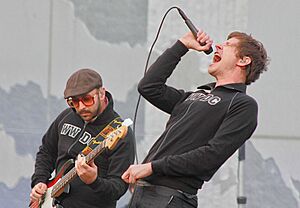
WWDC 2010 sold out in just 8 days. Steve Jobs announced the iPhone 4. The name iPhone OS was changed to iOS. FaceTime and the iMovie app for iPhone were also announced.
2011: iCloud and Mac OS X Lion
WWDC 2011 sold out in only 12 hours. Apple showed its next generation of software. This included Mac OS X Lion, iOS 5, and iCloud. iCloud is Apple's cloud service. This was the last Apple event hosted by Steve Jobs.
2012: Apple Maps and Retina MacBook Pro
WWDC 2012 tickets sold out in under two hours. The keynote announced Apple Maps. New MacBook Air and MacBook Pro models were also shown. This included a MacBook Pro with a Retina Display. Apple also showed OS X Mountain Lion and iOS 6. For the first time, attendees could be as young as 13.
2013: iOS 7 Redesign
WWDC 2013 tickets sold out in just 71 seconds! Apple gave 150 free student scholarships. New Mac Pro and MacBook Air models were shown. Apple also unveiled OS X Mavericks and a completely redesigned iOS 7. A new music streaming service, iTunes Radio, was also announced.
2014: iOS 8 and Swift
WWDC 2014 introduced iOS 8, the biggest update to iOS since the App Store. OS X Yosemite was also shown, with a new look inspired by iOS. A new programming language called Swift was announced. This was a big deal for developers.
2015: Apple Music and Open Source Swift
WWDC 2015 announced new features for iOS 9 and OS X El Capitan. The first major software update for the Apple Watch was shown. Apple Music was announced. Apple also said that the Swift programming language would become open-source software.
2016: macOS Sierra and Siri for Developers
WWDC 2016 announced that OS X was renamed to macOS. The new version was called macOS Sierra. Updates to iOS 10, watchOS 3, and tvOS 10 were also shown. Apple allowed other developers to add features to Messages, Apple Maps, and Siri. A new app called Swift Playgrounds was introduced. It helps young people learn to code on iPad.
2017: Return to San Jose and iMac Pro
WWDC 2017 was held in San Jose, California, for the first time since 2002. Software announcements included iOS 11, watchOS 4, macOS High Sierra, and tvOS 11. New hardware included updates to iMac, MacBook, and MacBook Pro. The new iMac Pro and 10.5-inch iPad Pro were also shown. Apple also unveiled the smart speaker HomePod.
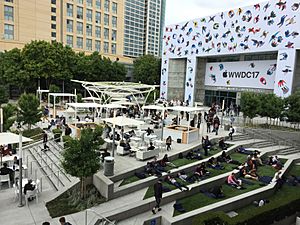
2018: Focus on Software
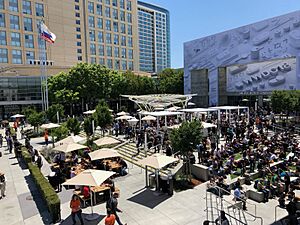
WWDC 2018 was held in San Jose. The announcements focused on software. This included iOS 12, macOS Mojave, watchOS 5, and tvOS 12. No new hardware was announced this year.
2019: iPadOS and New Mac Pro
WWDC 2019 introduced iOS 13, macOS Catalina, watchOS 6, and tvOS 13. A new operating system, iPadOS 13, was announced specifically for iPads. The 3rd generation Mac Pro and the Pro Display XDR screen were also shown.
2020s: Online and Hybrid Events
2020: Online-Only and Apple Silicon
WWDC 2020 was held completely online due to the COVID-19 pandemic. Major announcements included iOS 14, iPadOS 14, watchOS 7, tvOS 14, and macOS Big Sur. Apple also announced that Macs would start using their own custom ARM processors, called Apple silicon. The event had over 22 million views online.
2021: More Online Updates
WWDC 2021 was another online-only conference. iOS 15, iPadOS 15, watchOS 8, tvOS 15, and macOS Monterey were announced. No new hardware was shown this year.
2022: Hybrid Event and M2 Chip
WWDC 2022 was mostly online, but there was a special in-person day at Apple Park. iOS 16, iPadOS 16, watchOS 9, tvOS 16, and macOS Ventura were announced. The new M2 chip was introduced. Updated MacBook Air and 13-inch MacBook Pro models with the M2 chip were also shown.
2023: Vision Pro and New Macs
WWDC 2023 was a hybrid event with online sessions and an in-person experience at Apple Park. Apple introduced macOS 14 Sonoma, iOS 17, iPadOS 17, watchOS 10, and tvOS 17. For hardware, they announced the Apple M2 Ultra chip for Macs. New 15-inch MacBook Air, Mac Studio, and Mac Pro models were also shown. Apple also unveiled their new AR/VR headset, the "Apple Vision Pro."
2024: Apple Intelligence
WWDC 2024 was held online with an in-person event at Apple Park. iOS 18, iPadOS 18, watchOS 11, macOS 15 Sequoia, and visionOS 2 were announced. A big focus was on Apple Intelligence, which is AI designed for Apple devices. No new hardware was announced.
2025: Liquid Glass Design
WWDC 2025 took place online with an in-person event at Apple Park. New versions of all Apple's operating systems were announced. This included iOS 26, iPadOS 26, watchOS 26, macOS 26 Tahoe, tvOS 26, and visionOS 26. Apple also introduced a new design style called Liquid Glass. No new hardware was announced.
Scholarships for Students
Since 2020, Apple has offered the Swift Student Challenge instead of traditional scholarships. This is a programming contest held before WWDC. It focuses on the Swift programming language. About 350 winners are chosen each year. They receive WWDC-themed clothes, a special pin set, and a one-year membership to the Apple Developer Program. Since 2022, they also get a pair of AirPods Pro. In 2023, some winners could also enter a lottery to attend WWDC in person. In 2024, the top 50 winners were guaranteed to attend in person.
To enter, students create an interactive scene using Swift Playgrounds. This is an Apple app that teaches coding. The projects are judged on how well they are made, how creative they are, and the text that comes with them.
The challenge is open to students aged 13 or older. They must be enrolled in school or recently graduated. They cannot be working full-time as developers. Students can win the award up to four times.
Other Events
Several other conferences happen around WWDC each year. These are organized by other companies. Some famous podcasters also hold events nearby.
In the past, Apple also announced new products at other big shows. Now, Apple holds its own "special events" throughout the year for product introductions. Sometimes, products are released without any event at all.
See also
 In Spanish: Apple Worldwide Developers Conference para niños
In Spanish: Apple Worldwide Developers Conference para niños
- Apple Inc. advertising
- Apple Music Festival
- Google I/O
- Microsoft Build
- List of Apple Inc. media events


